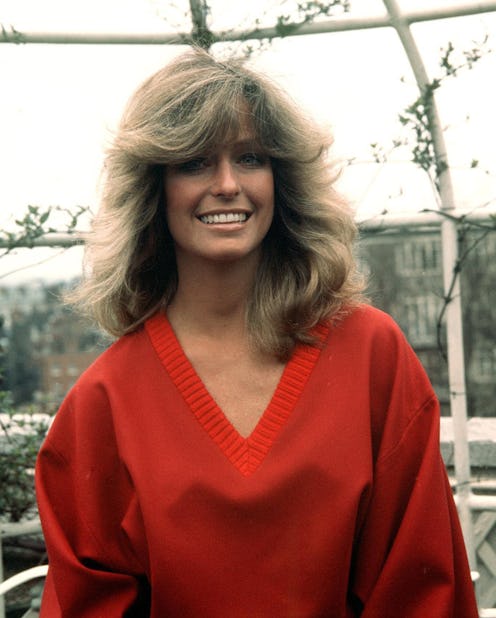(Beauty)
This '70s Hair Trend Is Back & Better Than Ever

Over the decades, we've seen hair trends veer more and more demure. There's less drama, less volume, and all-around less maintenance. But this year, with the times proving much different than ever before, people are going against the grain and leaning into the unexpected. Rather than searching for something fresh or innovative to try with their hair, people are turning to celebs of decades past for inspiration. Case in point: Farrah Fawcett hair, a looked marked by feathered layers and dramatic bangs, is now trending all over social media platforms like TikTok and Twitter. And, according to experts, this surge in the need for volume and curls, no matter your hair texture, is no coincidence.
Laura Polko, responsible for the luscious waves of Lucy Hale and Gigi Hadid, says love for the look made famous by Fawcett stems from the love of another popular hairstyle that came before. "Coming off of a decade where the bouffant was one of the most popular hairstyles, I think people loved the Farrah because of its ultra femininity and softness," she tells TZR. "It changed the way women wore their hair because it was a new soft hairstyle and worked on everyone in some shape or form."
And Larry Sims, Gabrielle Union and Alicia Keys' go-to hairstylist, agrees. "Farah Fawcett’s classic look felt so dreamy on Charlie’s Angels, making the feather hairstyle a staple," he says. "It actually became transformative through the decades. People rocked it through the '70s, '80s down to the '90s, and, as we see now, today. It’s making a comeback." Sims adds that, as the years have passed, other influential staples of pop culture helped the look to evolve. "Fawcett really kicked off the look in the '70s," he says. "In the '80s, we had music icon Janet Jackson who wore it, and in the 90’s, the queen of R&B, Mary J. Blige, rocked the hot feather look while adding her individual edge to the style."
So as we've all been relegated to buns and ponytails, the surge of voluminous hair is no coincidence. "Volume feels like a sense of freedom," Sims says. "When we tame our hair with a style such as a blowout, we have to make sure the weather or humidity doesn’t change or influence it. For most of the year, we have been controlled in our homes, so now people just want freedom. Our hair can create this freedom. Big hair is light, feels freeing and allows us to deviate from the normal standard. With big hair, you are allowing the hair to what it does organically, while still being effortless and totally free."
And, according to Polko, the TikTokers, often ahead of trends, have been the most eager about this hair freedom. "I think for the TikTok generation, nostalgia is really big," Polko says. "The Farrah style is so iconic and so easy to recreate at home. Voluminous hair is so fun and sexy, so it's easy to love!"
However, unlike other recent popular hairstyles, recreating the Farrah requires more than lots of hairspray and rollers. "The key to achieving this look is a layered cut, and specifically, position layers," Sims says. "First, the hair is blown out and a licensed cosmetologist cuts universal layers in the hair. If you want to wear the ‘Farrah Fawcett’ feather look, whether you hair is curly, wavy, or straight, the hairstyle needs to start with the foundation and the cut. Once the cut is there, you can let it go and style to your desire."
Polko suggests using a hot tool first, then blow drying after. "To create the look at home, use a large barrel curling iron, collecting one-inch sections and curling away from the face." She also insists that creating a clean, middle part is also important. Finally, roll away from the face using your blow dryer and brush, as this creates added smoothness and volume. Once styled, Sims suggests using a volumizing spray, like Flawless by Gabrielle Union's Hydrating Curl Refresher, for hold, additional texture, hydration, and megawatt shine.
We only include products that have been independently selected by The Zoe Report's editorial team. However, we may receive a portion of sales if you purchase a product through a link in this article.
This article was originally published on